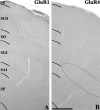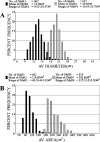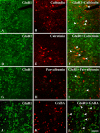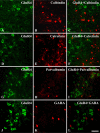Glutamate receptors GluR1 and GluR4 in the hamster superior colliculus: distribution and co-localization with calcium-binding proteins and GABA
- PMID: 19492025
- PMCID: PMC2685021
- DOI: 10.1267/ahc.08035
Glutamate receptors GluR1 and GluR4 in the hamster superior colliculus: distribution and co-localization with calcium-binding proteins and GABA
Abstract
We investigated the distributions of AMPA glutamate receptor subtypes GluR1 and GluR4 in the hamster superior colliculus (SC) with antibody immunocytochemistry and the effect of enucleation on these distributions. We compared these labelings to those of GluR2/3 in our previous report (Park et al., 2004, Neurosci Res., 49:139-155) and calcium-binding proteins calbindin D28K, calretinin, parvalbumin, and GABA. Anti-GluR1-immunoreactive (IR) cells were scattered throughout the SC. By contrast, anti-GluR4-IR cells formed distinct clusters within the lower lateral stratum griseum intermediale (SGI) and lateral stratum album intermediale (SAI). The GluR1- and GluR4-IR neurons varied in size and morphology. The average diameter of the GluR1-IR cells was 13.00 microm, while the GluR4-IR cells was 20.00 microm. The large majority of IR neurons were round or oval cells, but they also included stellate, vertical fusiform and horizontal cells. Monocular enucleation appeared to have no effect on the GluR1 and GluR4 immunoreactivity. Some GluR1-IR cells expressed calbindin D28K (9.50%), calretinin (6.59%), parvalbumin (2.53%), and GABA (20.54%). By contrast, no GluR4-IR cells expressed calcium-binding proteins or GABA. Although the function of the AMPA receptor subunits in SC is not yet clear, the distinct segregation of the GluR subunits, its differential colocalization with calcium-binding proteins and GABA, and differential responses to enucleation suggest the functional diversity of the receptor subunits in visuo-motor integration in the SC.
Keywords: AMPA glutamate receptors; GABA; calcium-binding proteins; immunocytochemistry; localization.
Figures







Similar articles
-
Ionotropic glutamate receptor GluR2/3-immunoreactive neurons in the cat, rabbit, and hamster superficial superior colliculus.Neurosci Res. 2004 Jun;49(2):139-55. doi: 10.1016/j.neures.2004.02.009. Neurosci Res. 2004. PMID: 15140557
-
Ionotropic glutamate receptor GluR1 in the visual cortex of hamster: distribution and co-localization with calcium-binding proteins and GABA.Acta Histochem Cytochem. 2006 Apr 22;39(2):47-54. doi: 10.1267/ahc.05058. Epub 2006 Mar 17. Acta Histochem Cytochem. 2006. PMID: 17375209 Free PMC article.
-
Distribution of AMPA glutamate receptor GluR1 subunit-immunoreactive neurons and their co-localization with calcium-binding proteins and GABA in the mouse visual cortex.Mol Cells. 2006 Feb 28;21(1):34-41. Mol Cells. 2006. PMID: 16511345
-
Immunocytochemical Localization of Calbindin D28K, Calretinin, and Parvalbumin in Bat Superior Colliculus.Acta Histochem Cytochem. 2014 Jun 28;47(3):113-23. doi: 10.1267/ahc.14004. Epub 2014 Jun 26. Acta Histochem Cytochem. 2014. PMID: 25320408 Free PMC article.
-
The organization of GABAergic neurons in the mammalian superior colliculus.Prog Brain Res. 1992;90:219-48. doi: 10.1016/s0079-6123(08)63616-x. Prog Brain Res. 1992. PMID: 1321459 Review.
Cited by
-
TrkB Activation during a Critical Period Mimics the Protective Effects of Early Visual Experience on Perception and the Stability of Receptive Fields in Adult Superior Colliculus.J Neurosci. 2019 Jun 5;39(23):4475-4488. doi: 10.1523/JNEUROSCI.2598-18.2019. Epub 2019 Apr 2. J Neurosci. 2019. PMID: 30940716 Free PMC article.
-
Association of cerebral spinal fluid copper imbalance in amyotrophic lateral sclerosis.Front Aging Neurosci. 2022 Nov 17;14:970711. doi: 10.3389/fnagi.2022.970711. eCollection 2022. Front Aging Neurosci. 2022. PMID: 36466599 Free PMC article.
References
-
- Behan M., Jourdain A., Bray G. M. Calcium-binding protein (calbindin D28K) immunoreactivity in the hamster superior colliculus: ultrastructure and lack of co-localization with GABA. Exp. Brain Res. 1992;89:115–124. - PubMed
-
- Binns K. E. The synaptic pharmacology underlying sensory processing in the superior colliculus. Prog. Neurobiol. 1999;59:129–159. - PubMed
-
- Chalmers D. T., McCulloch J. Selective alterations in glutamate receptor subtypes after unilateral orbital enucleation. Brain Res. 1991;540:255–265. - PubMed
-
- Choi D. W. Glutamate neurotoxicity and disease of the nervous system. Neuron. 1988;1:623–634. - PubMed
-
- Cork R. J., Baber S. Z., Mize R. R. Calbindin D28K- and parvalbumin-immunoreactive neurons form complimentary sublaminae in the rat superior colliculus. J. Comp. Neurol. 1998;394:205–217. - PubMed

